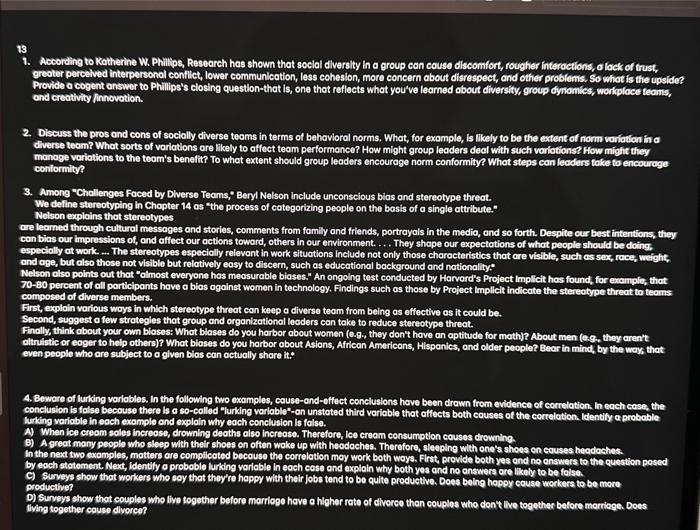fundamentals of management 10th edition by ricky griffin chapter 13

13 1. Aceording to Kotherine W. Phillps, Researeh has shown that social diversity in a group can couse discomfort, rougher interactions, a lack of trust, greoter percelved interpersonal conflict, lower communication, less cohesion, more concern about disrespect, and other problems, So what is the upside? Provide a cogent onswer to Phillips's closing question-that is, one that reflects what you've learned obout diversity, group dynomics, workploce feams, and creativity finnovotion. 2. Discuss the pros and cons of socially diverse teams in terms of behavioral norms. What, for example, is likely to be the extent of nom variation fin a diverse teom? What sorts of variations are likely to affect team performance? How might group leaders deal with such variotionst How might they manage variotions to the team's benefit? To what extent should group leaders encourage norm conformity? What steps can leoders take to encourcge conlormity? 3. Among "Challenges Faced by Diverse Teams," Beryl Nelson include unconscious bias and stereotype threat. We define stereotyping in Chopter 14 as "the process of cotegorizing people on the basis of a single attribute." Nelson explains that stereotypes ore leamed through cultural messoges and stories, comments from famlly and friends, portrayals in the medio, and so forth. Despite our best intentions, they con bias our impressions of, and affect our octions toward, others in our environment. ... They shape our expectotions of what people should be doing, especiolly at work... The stereotypes especially relevant in work situotions include not only those characteristics that are visible, such es sex, roce, weight, and age, but also those not visible but relatively easy to discern, such as educational bockground and notionality. Nelson olso points out that "olmost everyone has mesuroble biases." An ongoing test conducted by Harvard's Project lmplicit has found, for exemple, that 70-80 percent of all participants have a bias ogainst women in technology, Findings such as those by Project lmplicik indicate the stereotype threat to teams. composed of diverse members. First, explain various woys in which stereotype threat can keep a diverse teom from being as effective as it could be. Second, suggest a few strotegies that group and arganizotional leoders can toke to reduce stereotype threat. Finally, think about your owm biases: What blases do you harbor about women (e.g., they don't have an aptitude for math)? About men (e.g. they aren't altnistic or eoger to help others)? What biases do you harbor about Asians, African Americans, Hlspanics, and aider people? Bear in mind, by the way, that even people who are subject to a given bias can actually share it: 4. Beware of lurking variables, In the following two examples, ceuse-and-offect conclusions have been drawn from evidence of correlation. In each cese, the conclusion is false becouse there is a so-colled "lurking varlable"-on unstated third variable that atfects both causes of the correlation. Identify a proboble lurking variable in each example and explain why each concluston is folse. A) When lce cream soles increase, drowning deoths also increase. Therefore, lce cream consumption couses drowning. B) A great many people who sleep with thelr shoes on often woke up with heodaches. Therefore, sleeping with one's shoes en couses headoches. In the next two examples, motters are compllcoted becouse the correlation moy work both woys. First, provide both yes ond no enswers to the question posed by eoch statement. Next, ldently a proboble lurking varlable in each cose and explain why both yes and no answers ore likely to be false. C) surveys show that workers who scy that thoy're happy whth their jobs tend to be qulte productive. Does being happy couse workers to be more. producthe? D) Sunveys show that couples who live together before marrloge have a higher rate of dlvorce than couples who don' live togother before martioge. Does Alving together cause dlyorce








